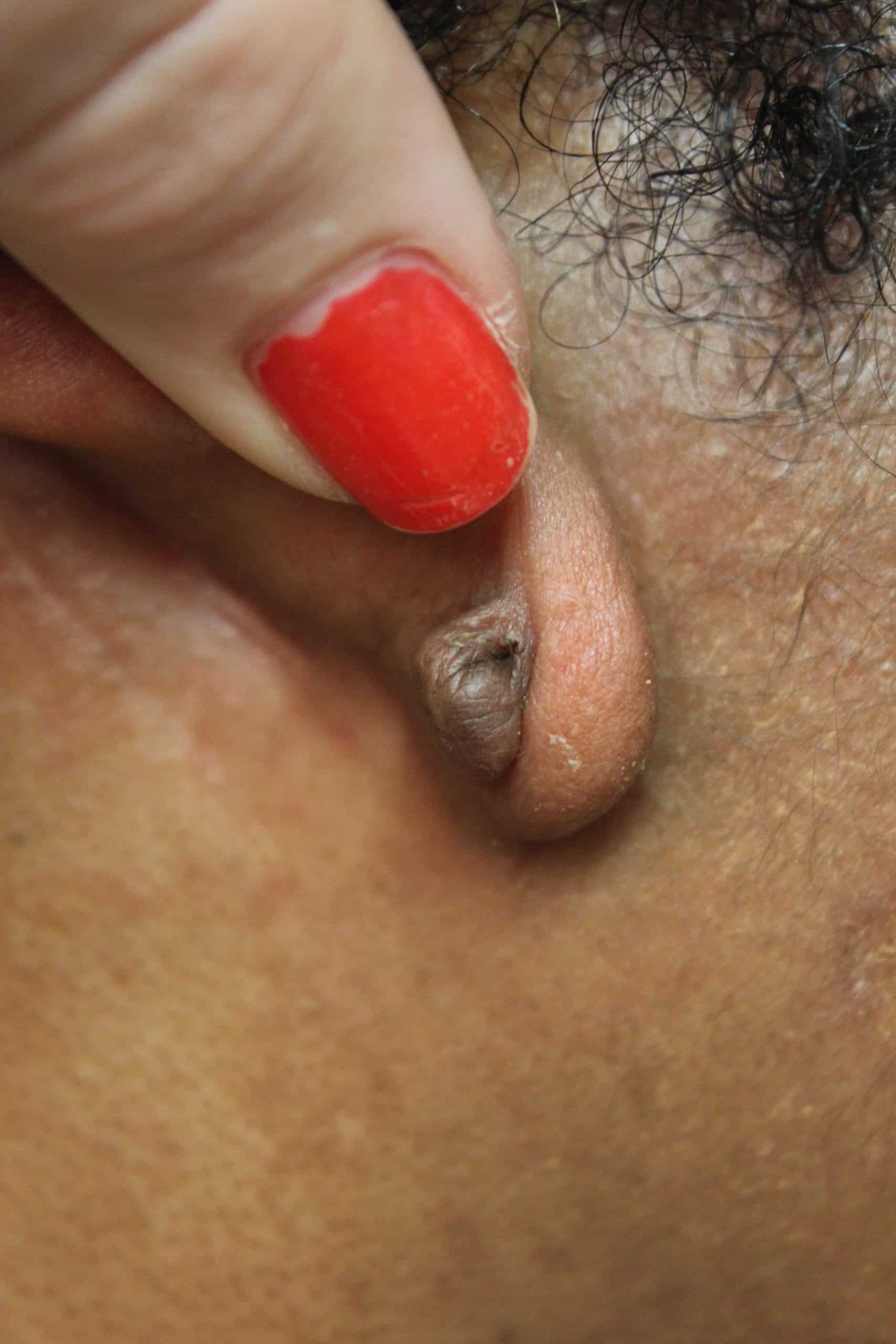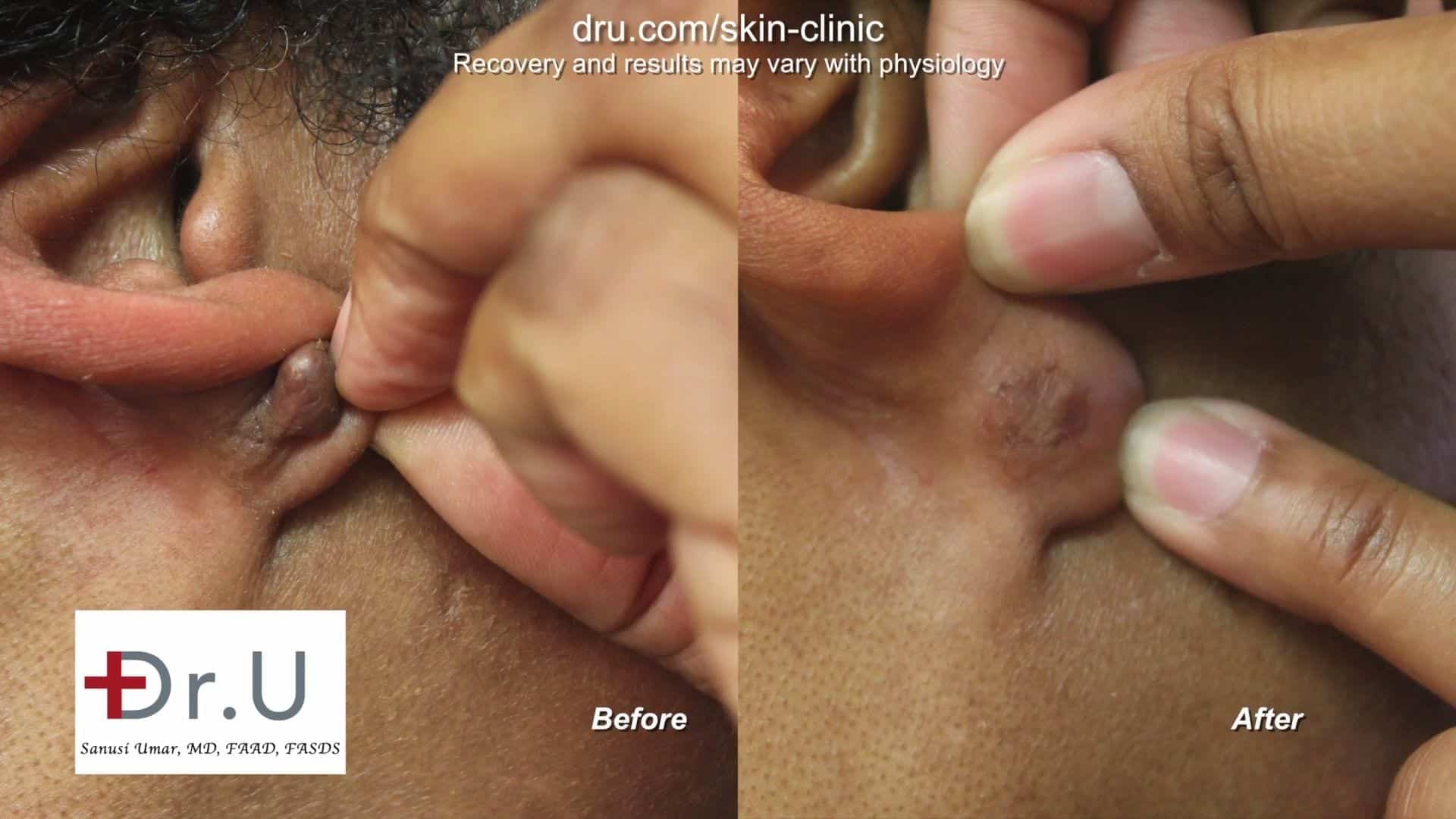What is a keloid? A keloid, also known as keloid scar or keloid skin, is a raised scar made up of specific types of collagen that continues to grow beyond the confines of its wound margins. Depending on its maturity, it will be made up of type III or type I collagen. Keloids come in a variety of shapes, sizes, and textures, such as:
- Rubbery firm texture
- Shiny and fibrous
Keloids also range in colors:
- Pink
- Skin colored
- Red
- Dark brown
Causes for Keloids and Symptoms
Following a cut or wound on the skin, keloids develop within the scar tissue. As the body attempts to repair the wound, the collagen overgrows, sometimes producing a large lump. Type III collagen, also known as granulation tissue, occurs in the earlier keloids, while type I occurs in the later forms. Piercings, severe acne, chickenpox scarring, infections, burns, vaccinations, repeated trauma to the skin or tension during wound closure can also be known to cause them; something as simple as a pimple, insect bite or scratch can, too. In terms of locations on the body, the most common areas include the chest, back, shoulders, earlobes, arms, pelvic region and the collarbone. The general theme is a predilection for areas of the body where the skin is under tension (stretched as in e.g. chest, collar bones) or pulling effect of gravity (e.g. an earlobe that is pulled down by a heavy earring after piercing). Although an injury is usually responsible for this type of scarring, keloids can occur spontaneously. They are also prone to growth, especially if they first appear at a younger age.
Keloid scars tend to have a genetic component, although no single gene has yet been identified. Keloids occur at a higher rate in those with darker skin, showing up most frequently in Africans and African Americans’ family history. They appear in 15 – 20% of individuals with African, Asian or Latino heritage and significantly less for those with a Caucasian background; there are no reported cases in patients with albinism. This type of scarring is also common in young people between the ages of 10 and 20. While keloids show up in both sexes, they occur at a higher rate in young females than in young males. This may be due to the higher frequency of earlobe piercings in young girls.
What are the symptoms of keloids on the ear?
The symptoms of keloids can include:
- An area of the earlobe that is skin-toned, red, or pink in color
- A ridged or bumpy area of earlobe skin that’s usually raised
- An area which increases in size over time with scar tissue
- A patch of itchy skin on the earlobe
- Itchy, stinging and burning sensations
Can Keloids Be Removed?
As a result of keloids being unsightly and in certain cases, uncomfortable, keloid removal services are available. While keloids are not dangerous or contagious, they can cause physical discomfort such as sharp pains, itching and changes in texture; the degree in which these symptoms occur will vary from person to person. However, if they become infected, ulceration can occur. Due to these reasons, people seek out keloid removal services.
If you are interested in keloid removal and have a question that might help you clarify further, do not hesitate to Ask Dr. U at no cost.
How To Remove Keloids
After developing a keloid scar, patients often wonder how keloids are removed. The method of treatment for keloid removal will vary from case to case and often depends on the patient’s age. Options include excision, pulsed dye laser treatment, corticosteroids, and antimetabolite injections (e.g. bleomycin) cryotherapy and Grenz zone radiation therapy, and pressure devices. However, radiotherapy, anti-metabolites and corticoids are not recommended for children due to potential side effects. When it comes to keloid removal, more severe consequences may ensue. The likelihood of the resulting surgery scar has more than a 50% chance of becoming a keloid.
Keloid-flap Surgical Excision
Surgical excision is the most common way to perform keloid removal. This surgery closes the keloid scar by using the keloid itself to form a flap. In his Los Angeles Clinic, Dr. U uses this method as a way to lower the need for indefinite steroid injections or maintained use. It also helps prevent further scarring and has a lower rate of the keloid returning. Other methods include:
- Cryotherapy for Keloid Removal: Cryotherapy freezes the keloid. It is best for smaller keloids, such as those from acne. This treatment runs the risk of lightening the skin.
- Corticosteroid Treatment for Keloid Removal: A corticosteroid treatment injects medicine into the keloid and is the most commonly used treatment method. It works well in conjunction with cryotherapy or following surgery.
- Medication for Keloid Removal: Medications such as verapamil, fluorouracil, bleomycin, and interferon alfa-2b shots are also used. They are not as well researched as corticosteroid shots and will most likely to work when used with another treatment.
- Radiation for Keloid Removal: Radiation of the Grenz zone as a stand-alone treatment is rarely done. Often Grenz zone radiation therapy following excision surgery is done. This has been found to be a very effective treatment with very little chance of recurrence. Dr. U uses this approach in complex wound closures in keloidal patients or instances where the wound is closed under significant tension.
Depending on each patient’s situation, more than one treatment method for keloid removal may be used. The size and location of the keloid will also be a main deciding factor. Patients are usually back to work in 1-2 days following keloid removal services; the stitches are removed in a few days.
Keloid Removal Results From Dr. U Skin Clinic Los Angeles
>Due to a piercing, this Los Angeles patient shown below was left with a Keloid on her earlobe. After using steroid injections with no success, she turned to Dr. Umar for help. Following the procedure, she was very happy with the earlobe keloid removal procedure.
Dr. U removed the keloid from the earlobe and then used a keloid-flap to close the scar. The flap prevents the scar-forming-signal the wound requires to form a scar. Often, keloids will end up growing back after surgery. However, this was not the case here.
Typically keloids would grow back sometimes even bigger after conventional surgery. In this case, it did not recur. The pictures below show results at one year after keloid removal. The results reveal a keloid free earlobe, without the need for steroid injections. Thanks to Dr. U’s unconventional treatment, the results are impressive. The patient is left with an aesthetically pleasing earlobe and fast recovery time.
Before Photo of Earlobe Keloid Removal

After Photo of Earlobe Keloid Removal Treatment

After receiving earlobe keloid removal treatment, this Los Angeles patient is left with a keloid free earlobe a year after the surgery.
Patient Results Video: Earlobe Keloid Removal By Dr. U Flap Method
Keloid Removal Services Los Angeles
The Office of Dr. U provides patients with a comfortable experience to those interested in keloid removal services. To get started, fill out our consultation form or call us at (310) 318-1500 to schedule an appointment.
Keloid Removal Services Los Angeles FAQ
Who is a good candidate for keloid removal services?
Any physically healthy person who wants to remove their keloid could be an ideal candidate.
What can I expect in terms of keloid removal cost?
The total cost varies, depending on the size of the keloid, the location of the scar, the area of the clinic, the doctor and the method used. The average cost of keloid removal anywhere from $350 to $2,500.
What makes keloids form after surgery or injury?
The answer to this question is still not fully clear. However, keloids are more prevalent in people with darker skin tones– such as individuals of African or Asian descent. A genetic predisposition amongst individuals of these ethnicities seems to be the reason for this.
Which procedure does Dr. U think should be used to get rid of my keloid?
Dr. U is an expert in Keloid removal, offering individualized treatment plans to ensure success. Following a private consultation with him, he will be able to determine the best method of removal for you.
Will my insurance pay for my keloid removal procedure?
Unfortunately, insurance does not cover cosmetic procedures unless there is some medically necessary component. If your Keloid is inhibiting normal function, you may be in luck.
Have more questions about keloid removal services? Ask Dr. U using the button below.
Further Reading
See how Dr. Umar repairs a split earlobe with minimal scarring.
Learn more about the cost of procedure and financing options.
